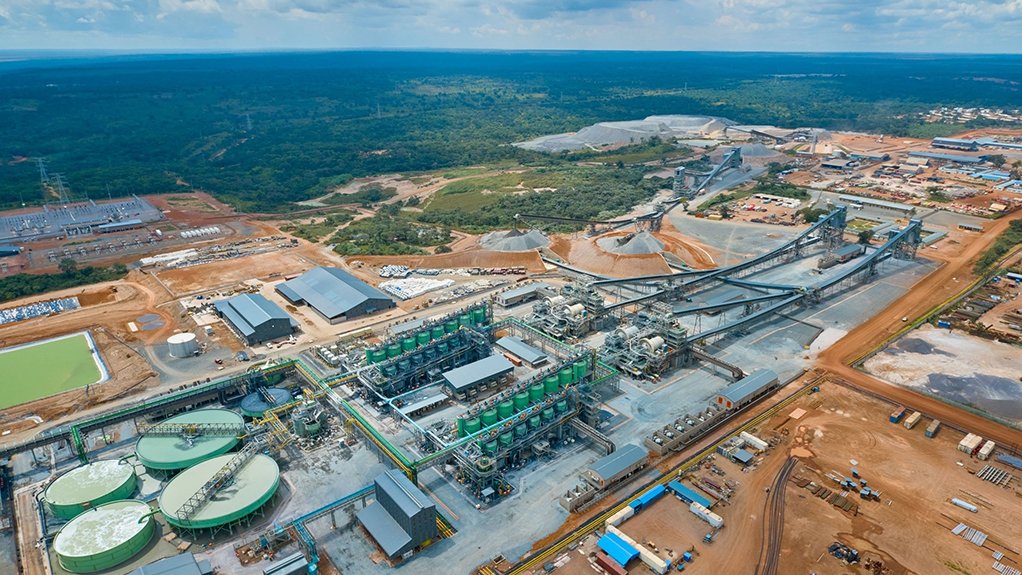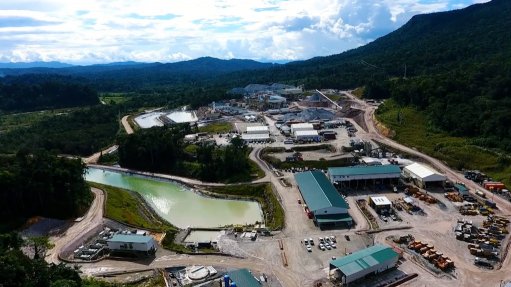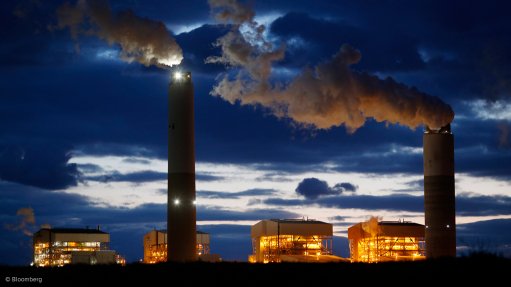Kamoa-Kakula shown to produce least carbon intensive copper globally
An updated current and future greenhouse-gas (GHG) emissions assessment of the Kamoa-Kakula copper complex, in the Democratic Republic of Congo (DRC), conducted by independent consultants Skarn Associates of London, England, and WSP Group of Montreal, Canada, has confirmed that, in 2022, the operation produced among the lowest carbon emissions per unit of copper in the world, and the lowest of any major copper mine.
This is partially owing to the very high-grade orebodies at Kamoa-Kakula, with ore milled at an average grade of 5.5% in 2022, about ten times higher than the estimated average copper head grade globally of 0.6%.
It is also a function of the DRC grid being among the world’s cleanest, with 99.5% of grid power generated from hydroelectricity, according to the US Energy Information Administration. This includes investments in hydropower generation that Kamoa Copper has made in partnership with DRC State utility Société Nationale d'Electricité (SNEL), such as the completed 78 MW Mwadingusha hydroelectric facility and the ongoing work at Turbine #5 of the Inga II hydroelectric facility.
On a Scope 1 and 2 basis, reported from ore to mine gate, Kamoa-Kakula’s GHG emissions intensity in 2022 was 0.16 t of carbon dioxide-equivalent (CO2e) per tonne of contained copper produced. This puts Kamoa-Kakula almost at the bottom of the Scope 1 and 2 GHG emissions curve.
“The world is waking up to the fact that copper is the undisputed metal of electrification, with even conservative forecasts predicting that demand will double in size by 2035, based on massive requirements from renewable energy generation, grid-scale transmission and storage infrastructure, and the electrification of mass transportation. . .
"There will absolutely be no energy transition to net-zero without a transformational increase in the amount of primary copper produced by the mining industry. However . . . mining companies [must] work to limit GHG emissions and safeguard the environment. The achievements at Kamoa-Kakula demonstrate that mining can indeed be reinvented to sustainably provide the metal . . . without compounding the problem of global warming and in harmony with our employees, local communities, government partners and stakeholders,” Ivanhoe Mines executive co-chairperson Robert Friedland said on November 2.
He added that Kamoa-Kakula was proof that the DRC could lead the market in terms of low-carbon copper production, with its unique high-grade mineral endowment, robust hydropower potential and rapidly improving infrastructure, such as the Lobito Corridor.
Kamoa-Kakula’s ongoing Phase 3 expansion, which is on schedule to be completed in the fourth quarter of next year, consists of a new five-million-tonne-a-year underground mine and concentrator at Kamoa, an on-site direct-to-blister flash copper smelter, as well as the refurbishment of Turbine #5 at the Inga II hydroelectric power station.
Turbine #5 will supply an additional 178 MW of clean hydroelectric power to the national grid, which is sufficient to meet the power requirements of the Phase 3 concentrator, the smelter, as well as provide spare capacity for the DRC grid and future expansions.
The new direct-to-blister flash copper smelter is projected to be one of the largest single-line copper flash smelters in the world, and the largest in Africa. The smelter will have a nameplate production capacity of 500 000 t/y of more than 99%-pure blister copper anodes.
The 100-ha smelter complex is under construction adjacent to the operating Phase 1 and Phase 2 concentrator plants. The smelter has been designed to incorporate modern direct-to-blister technology supplied by Metso Outotec of Espoo, Finland, and will meet the International Finance Corporation’s (IFC’s) emission standards.
The smelter will have a processing capacity of about 1.2-million tonnes a year of dry concentrate feed and is designed to run on a blend of concentrate produced from the adjacent Phase 1 and 2 concentrators at Kakula and the Phase 3, as well as future Phase 4, concentrators at Kamoa, located about 10 km away.
According to the assessment completed by Skarn and WSP, the smelter will have one of the world’s lowest Scope 1 and 2 GHG emission intensities. It is estimated to produce 0.36 CO2e/t of copper. Out of the about 100 copper smelters analysed globally, the smelter is estimated to rank fourth lowest in terms of GHG emissions.
The construction of the smelter is on track to be completed in the fourth quarter of next year.
On the basis of Scope 1, 2 and 3 (partial) emissions, including downstream emissions beyond the mine gate to produce London Metal Exchange-grade refined metal, Skarn and WSP estimated that Kamoa-Kakula’s GHG emissions-intensity in 2022 was 2.42 CO2e/t of copper.
Following the completion of the Phase 3 expansion and the smelter, the emissions intensity of Kamoa-Kakula on a Scope 1, 2 and 3 basis is estimated to almost halve to 1.31 CO2e/t of copper.
The significant reduction in GHG emissions is owed to the improvement in Scope 3 emissions from the onsite smelter. This is partially owing to the smelter being inherently lower in GHG emissions-intensity compared with typical smelters currently used. The most significant impact is in terms of the transportation of a higher-grade copper anode, instead of shipping copper concentrate.
Currently, copper concentrate of about 50% copper, excluding moisture, is trucked up to 3 000 km to the ports of Durban, in South Africa; Dar es Salaam, in Tanzania; and Walvis Bay, in Namibia, where it is then exported to the international markets to be smelted.
Following the completion of the Kamoa-Kakula copper smelter, copper will be transported to port in the form of 99.7% pure copper anodes. Therefore, transporting anode with more than double the contained copper content, compared with concentrate, requires under half the number of trucks per unit of copper.
In addition, sulphur dioxide off-gas generated from the smelting process is captured to produce high-strength sulphuric acid. This by-product will be sold in liquid form domestically within the DRC copperbelt.
This further reduces the GHG emissions of local mining operations that consume sulphuric acid to leach copper from oxide ores. These operations are located between 20 km and 60 km away from Kamoa-Kakula.
Moreover, 95% of the sulphuric acid used in the DRC is generated from energy-intensive sulphur furnaces that burn sulphur powder that is imported from as far as the Port of Durban. Purchasing high-strength sulphuric acid domestically provides local mining operations with significant GHG emissions savings, owing to the proximity of the smelter and the method by which the acid is generated.
To support the further reduction of downstream Scope 3 GHG emissions, Ivanhoe said that Kamoa-Kakula is working with its offtake partners. This includes targeting low-emission copper refineries where commercially feasible, as well as supporting lower carbon-intensive logistics routes, such as the Lobito Railway Corridor.
Kamoa-Kakula plans to start trial shipments along this corridor in the fourth quarter. The new Lobito Railway Corridor is a significantly shorter and more direct route to a seaport than the current export routes. On completion of the trial shipments, Kamoa-Kakula will be able to estimate the GHG emissions savings from using this route, compared with the current trucking routes.
In addition, the refurbishment of Turbine #5 at the Inga II hydroelectric facility is about 50% complete and advancing on-schedule, and well within budget, for completion in the fourth quarter of next year, the company said.
Originally built in the 1980s, the Inga II hydroelectric facility consists of eight turbines with a total generation capacity of 1.4 GW. However, the facility currently operates at about 50% use, with Turbine #5 having been non-operational since 2018.
The new equipment installed as part of the refurbishment work contains in total about 100 t of copper. The removal of the old turbine and associated equipment is complete, with the delivery of all the new replacement equipment expected within the coming months.
Comments
Press Office
Announcements
What's On
Subscribe to improve your user experience...
Option 1 (equivalent of R125 a month):
Receive a weekly copy of Creamer Media's Engineering News & Mining Weekly magazine
(print copy for those in South Africa and e-magazine for those outside of South Africa)
Receive daily email newsletters
Access to full search results
Access archive of magazine back copies
Access to Projects in Progress
Access to ONE Research Report of your choice in PDF format
Option 2 (equivalent of R375 a month):
All benefits from Option 1
PLUS
Access to Creamer Media's Research Channel Africa for ALL Research Reports, in PDF format, on various industrial and mining sectors
including Electricity; Water; Energy Transition; Hydrogen; Roads, Rail and Ports; Coal; Gold; Platinum; Battery Metals; etc.
Already a subscriber?
Forgotten your password?
Receive weekly copy of Creamer Media's Engineering News & Mining Weekly magazine (print copy for those in South Africa and e-magazine for those outside of South Africa)
➕
Recieve daily email newsletters
➕
Access to full search results
➕
Access archive of magazine back copies
➕
Access to Projects in Progress
➕
Access to ONE Research Report of your choice in PDF format
RESEARCH CHANNEL AFRICA
R4500 (equivalent of R375 a month)
SUBSCRIBEAll benefits from Option 1
➕
Access to Creamer Media's Research Channel Africa for ALL Research Reports on various industrial and mining sectors, in PDF format, including on:
Electricity
➕
Water
➕
Energy Transition
➕
Hydrogen
➕
Roads, Rail and Ports
➕
Coal
➕
Gold
➕
Platinum
➕
Battery Metals
➕
etc.
Receive all benefits from Option 1 or Option 2 delivered to numerous people at your company
➕
Multiple User names and Passwords for simultaneous log-ins
➕
Intranet integration access to all in your organisation





















